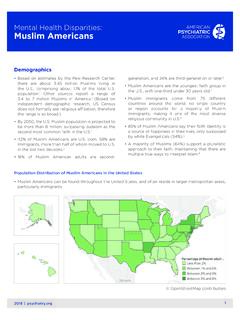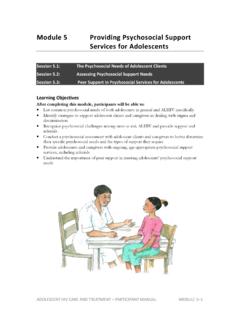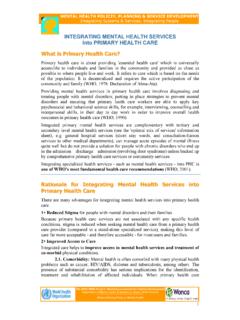Transcription of Cultural Competence in Mental Health - Mental Illness
1 The UPenn Collaborative on Community Integration is a Rehabilitation Research & Training Center Promoting Community Integration of Individuals with Psychiatric Disabilities, funded by the National Institute on Disability and Rehabilitation Research. For more information, please visit us at: What Is Culture? Culture may be defined as the behaviors, values and beliefs shared by a group of people, such as an ethnic, racial, geographical, religious, gender, class or age group. Everyone belongs to multiple Cultural groups, so that each individual is a blend of many influences.
2 Culture includes or influences dress, language, religion, customs, food, laws, codes of manners, behavioral standards or patterns, and beliefs. It plays an important role in how people of different backgrounds express themselves, seek help, cope with stress and develop social supports. Culture affects every aspect of an individual s life, including how we experience, understand, express, and address emotional and Mental distress. What Is Cultural Competence ? Cultural Competence is the ability to relate effectively to individuals from various groups and backgrounds.
3 Culturally competent services respond to the unique needs of members of minority populations and are also sensitive to the ways in which people with disabilities experience the world. Within the behavioral Health system (which addresses both Mental illnesses and substance abuse), Cultural Competence must be a guiding principle, so that services are culturally sensitive and provide culturally appropriate prevention, outreach, assessment and intervention. Cultural Competence recognizes the broad scope of the dimensions that influence an individual s personal identity.
4 Mental Health professionals and service providers should be familiar with how these areas interact within, between and among individuals. These dimensions include: race ethnicity language sexual orientation gender age disability class/socioeconomic status education religious/spiritual orientationDiversity in the United States The population is rapidly diversifying: The decade between 1990 and 2000 saw the largest increase from 20 percent to 25 percent in population growth of persons of color. According to the 1990 census, the number of persons who speak a language other than English rose 43 percent, to million, compared with 1980 census figures.
5 Nearly 45 percent of these million people indicated having trouble speaking English. One in 10 Americans are now foreign-born. One in three Americans belongs to a group or groups identified as minorities. Cultural Competence in Mental Health The UPenn Collaborative on Community Integration is a Rehabilitation Research & Training Center Promoting Community Integration of Individuals with Psychiatric Disabilities, funded by the National Institute on Disability and Rehabilitation Research. For more information, please visit us at: The diversity that exists within groups is often overlooked.
6 For example: o The term Asian American includes people from a variety of nations, such as Afghanistan, China, India, Syria and Japan. It includes both immigrants and those whose families have lived in the United States for generations. o The term African American implies that million people share certain characteristics because of their ties with some of the 797 million people in Africa, who live in 54 different countries and speak some two thousand different languages. o The term Native American includes people who may be of unmixed ancestry or whose Native American lineage is only a fraction of their backgrounds, who may trace their roots to any of more than 500 different tribes, and who may or may not identify with tribal culture.
7 O According to 2006 Census Bureau estimates, some million Americans were identified as Hispanic. Within this group, 64 percent were of Mexican background, 9 percent were of Puerto Rican background, percent Cuban, 3 percent Salvadoran and percent Dominican. The remainder are of some other Central American, South American, or other Hispanic or Latino origin. With the increasing diversity of the population, Mental Health service providers must be aware of the influences that culture has on psychological processes, Mental illnesses, and the ways that people seek help.
8 They must also be aware of the variety within groups. Disparities in Mental Health Services The Surgeon General s report Mental Health : Culture, Race and Ethnicity discusses disparities in behavioral Health services for members of racial and ethnic minority populations. People in these populations: are less likely to have access to available Mental Health services; are less likely to receive necessary Mental Health care; often receive a poorer quality of treatment; and are significantly underrepresented in Mental Health research. Members of racial minority groups, including African Americans and Latinos, underuse Mental Health services and are more likely to delay seeking treatment.
9 Consequently, in most cases, when such individuals seek Mental Health services they are at an acute stage of Illness . This delay can result in a worsening of untreated Illness and an increase in involuntary services. Generally, rates of Mental disorders among people in most ethnic minority groups are similar to rates for Caucasians. However, members of minority populations are more likely to experience factors such as racism, discrimination, violence and poverty that may exacerbate Mental illnesses. Cultural Competence in Mental Health The UPenn Collaborative on Community Integration is a Rehabilitation Research & Training Center Promoting Community Integration of Individuals with Psychiatric Disabilities, funded by the National Institute on Disability and Rehabilitation Research.
10 For more information, please visit us at: Cultural disparities include the following: o For decades, studies have shown that African Americans are more likely to be misdiagnosed with schizophrenia than any other ethnic group. Reasons for this remain unclear. o A protein that metabolizes several antidepressant medications is less active in East Asians. This increases the risk of higher blood levels of medication and more side effects within members of this population, indicating that everyone doesn t respond to and metabolize medication in the same way and at the same rate.









